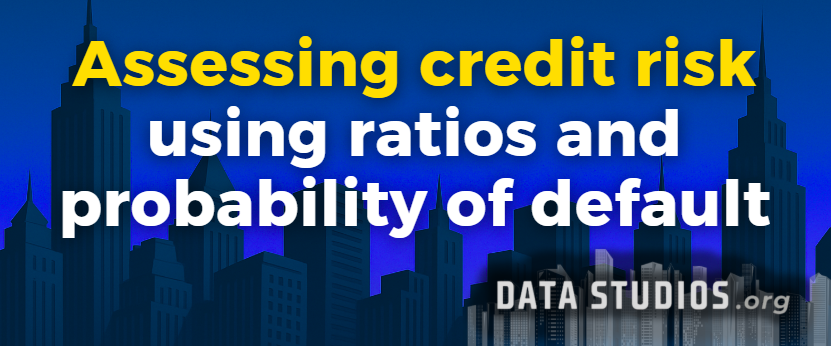Assessing credit risk using financial ratios and probability of default: Tools, interpretation, and practical application
- Graziano Stefanelli
- Sep 14
- 3 min read

Credit risk analysis is a cornerstone of lending, investing, and corporate finance decisions.
Every time a lender provides a loan, a supplier extends payment terms, or an investor buys a bond, they accept the risk that the borrower might not repay as agreed. Assessing credit risk is about estimating the likelihood and severity of such default, using a mix of financial analysis, probability modeling, and expert judgment. For corporations, this process is equally important for managing relationships with banks, suppliers, and the capital markets.
The role of financial ratios in credit risk analysis.
Financial ratios provide an objective, comparable way to evaluate a borrower’s ability to meet its obligations. Lenders, rating agencies, and credit analysts rely on key categories:
Ratio Type | Key Ratios | Purpose |
Leverage | Debt/Equity, Debt/EBITDA, Debt/Assets | Assess overall indebtedness and risk of over-leverage |
Liquidity | Current Ratio, Quick Ratio, Cash Ratio | Measure ability to pay short-term obligations |
Coverage | Interest Coverage, EBITDA/Interest, FFO/Interest | Gauge ability to cover interest from operating earnings |
Profitability | Return on Assets (ROA), Net Margin | Understand sustainable income generation |
Cash flow | Operating Cash Flow/Debt, Free Cash Flow/Debt | Analyze recurring cash to service debt |
Example:
A company with Debt/EBITDA of 5.5x, interest coverage of 1.2x, and a current ratio below 1.0 would be considered high risk by most lenders.
The probability of default (PD): quantitative approaches to risk estimation.
Probability of default (PD) is the estimated likelihood that a borrower will fail to meet its obligations within a specified period (typically one year). Financial institutions and investors use various models:
Credit scoring models: Statistical analysis using historical data (e.g., Altman Z-score, Ohlson O-score).
Logistic regression and machine learning: Predict PD based on a wide range of borrower, financial, and macroeconomic variables.
Credit ratings and agency models: Agencies like S&P, Moody’s, and Fitch assign ratings with implied PD bands (e.g., “BBB” ~ 0.2% annual default probability).
Market-based models: Use bond spreads, credit default swaps, or equity volatility to infer market-implied PD.
Example:
A BBB-rated corporate bond may have a 0.2–0.3% annual PD, while a CCC-rated issuer could have a PD above 20%.
Integrated credit risk assessment process.
Financial ratio analysis:
Review at least three years of historical and projected ratios; look for trends and stress points.
Qualitative assessment:
Consider management quality, business model, sector risk, governance, and market position.
External credit ratings:
Benchmark company risk to peers and industries using agency reports or scoring tools.
Modeling PD and loss given default (LGD):
Estimate both the likelihood and severity of loss in the event of default.
Scenario analysis and stress testing:
Evaluate credit risk under adverse scenarios—economic downturns, revenue shocks, or rising rates.
Practical application: supplier and customer credit assessment.
Corporates apply the same credit risk toolkit in commercial relationships:
Supplier risk: Assess whether key suppliers can weather downturns, to avoid supply chain disruption.
Customer credit: Set payment terms, credit limits, or require collateral for customers with weaker ratios or high PDs.
Example: Credit analysis for a mid-sized manufacturer.
Metric | Company A | Industry Median | Interpretation |
Debt/EBITDA | 4.2x | 3.0x | High leverage, elevated risk |
Interest Coverage | 1.5x | 3.8x | Low buffer for debt service |
Current Ratio | 1.1 | 1.5 | Tight liquidity |
Z-score | 2.0 | 2.7 | Borderline “grey zone” (Altman) |
Moody’s rating | Ba2 | — | Non-investment grade (high yield) |
Conclusion:
This profile would lead to conservative lending terms, higher pricing, or tighter covenants.
Limitations and best practices in credit risk analysis.
Backwards-looking bias: Ratios are based on past data; sudden shifts or fraud may go undetected.
Industry differences: Benchmarks vary widely across sectors; context is key.
Model risk: Quantitative models may overfit or fail to capture black swan events.
Qualitative factors: Management action, market disruption, or regulatory change can override numerical indicators.
Best practices:
Always combine ratio analysis with forward-looking scenario planning and qualitative judgment.
Track covenant compliance and warning signs—missed payments, rating downgrades, negative news.
Reassess credit exposures regularly, especially as market or business conditions change.
Assessing credit risk is fundamental for protecting financial stability, optimizing capital allocation, and building resilient relationships.
A rigorous blend of financial ratio analysis and probability modeling allows companies, lenders, and investors to price risk, structure agreements, and prepare for downside scenarios. As markets and credit cycles evolve, disciplined credit analysis remains the foundation of sound lending, investing, and risk management practices.
____________
FOLLOW US FOR MORE.
DATA STUDIOS




